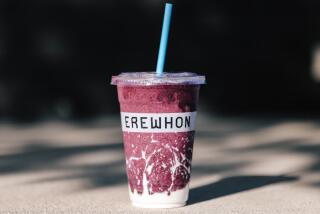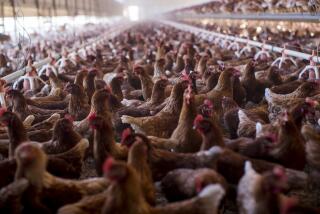PET FOOD SPECIAL : Itâs Dining Cats and Dogs
Every week Genora Hall makes a kettle of vegetable soup, meatloaf and a big pot of pasta or rice. Her husband, Rick, especially loves the carrot-studded meatloaf. He says it makes a great sandwich.
Hall occasionally has a bowl of the soup but she tries not to eat too much of it. Otherwise, she says, âIâll just have to make more.â
She means sheâll just have to make more soup for the intended recipients--her dogs.
Although her four big chow hounds get a daily ration of kibble, she supplements their diet with vitamins and home-cooked meals.
âI call it preventive ... holistic ,â says Hall, after groping for a better term. âI hate using that word because then people think you are a screwball. And Iâm not.â
Hall runs Adopt-A-Pooch, a volunteer group dedicated to finding homes for orphan dogs, and doesnât really have time to cook elaborate meals for herself, much less her pets. âI know someone who roasts a turkey once a week for her dog,â she says. âIâm much too busy for that.â
Certain pets have always enjoyed home-cooked meals--think of the French and their pampered lap dogs. But these days, even middle-class dogs and cats are getting specially cooked chow--and itâs more than just a few table scraps or the bone from the Sunday roast. Just as owners have become more health conscious about their own diets, theyâre worrying about what their pets are eating too. They read pet food labels and are more selective in choosing products. The old supermarket kibble just wonât do anymore.
Certainly pet food manufacturers know theyâve got an attentive audience. Just check out the pet food aisle at your local supermarket. Only cereal and soft drinks occupy more shelf space. And then thereâs the fastest growing division--premium pet food, sold at pet stores, grooming shops and veterinary clinics where kibble can really run up a big chunk of change.
But despite all the beefy dinners, butcher blends, kibble and chicken nuggets to choose from, some feel itâs dog-gone impossible to find a completely wholesome pet food. Only home-cooked will do for these choosy owners.
âHow would you like it if all you had to eat every day was Grape-Nuts?â says Dr. Richard Pitcairn, the Euell Gibbons of pet food, when asked about commercial kibble. âWell, the high point of a dogâs day is getting fed and look what youâre giving her.â
Pitcairn thinks he knows what constitutes a good pet diet. But there are almost as many different feeding philosophies as there are experts. Many claim that four-footed creatures can live perfectly well on a scientifically formulated diet of meat and poultry byproducts as long as the necessary nutrients have been added. Others, like Pitcairn, are seriously concerned about the nutritional quality of animal convenience foods, and advise preparing a good home-cooked meal every day. Some are adamant about feeding a dog or cat as it would feed itself if it were living in the wild. There are those who advise a varied diet, while others believe the opposite, that pets are better off if theyâre fed the same diet every day as long as itâs completely balanced. One faction feeds their pets only raw foods, another cooks everything thoroughly.
âMost people want to feed their pets something that looks good,â says Pitcairn. âBut just because it looks good, does not necessarily mean itâs good for them. Being carnivores, dogs and cats need a lot more protein and more calcium than we do.â
*
In 1982, Pitcairn and his wife Susan published âDr. Pitcairnâs Complete Guide to Natural Health for Dogs & Cats,â one of the first books to focus on animal nutrition, now considered the bible of homeopathic pet health. At a time when most people were feeding their animals cans of stinky, purple dreck , the Pitcairns advised owners to feed pets the best whole, fresh food they could afford.
âWe see a big difference in animals that go on a good diet,â says Pitcairn. âA lot of chronic health problems are nutritional, either from food contamination or deficiencies. There are rules about what canât go into human food--although Iâm sure things slip in now or then--but most of them donât apply to pet food.â
Julie Zimmerman, a feed control officer for the State of Colorado and vice chair of the American Assn. of Feed Control Officials (AAFCO), a non-regulatory organization that formulates uniform regulations and nutritional guidelines pertaining to pet food, has a more positive view of commercial pet food, and even of that scary-sounding kibble staple, byproducts.
âWe may think [byproducts] are not real pleasant, but they contain good nutrition and are safe,â Zimmerman says. âOne of the things we do on a state level is randomly pull feed samples and have our own lab do an analysis. And we see a very low violation rate.â
*
Pat McKay, author of the animal nutrition book, âReigning Cats and Dogs,â isnât convinced. She stopped feeding her pets commercial food 25 years ago. Now her animalsâ menu consists only of fresh, raw foods. McKay believes that heat destroys nutrients and the enzymes necessary for easy digestion.
â âCookâ is a four-letter word as far as carnivores are concerned,â she says. âThere isnât an animal in the wild that eats anything that comes anywhere close to kibble. Mother Nature did a swell job. But people always think they know more.â
If it were up to her, McKay would encourage people to feed mice, birds, lizards and insects to their pets because thatâs what they ate in the wild. âBut if I did that,â she says, âIâd have a whole other animal activist group come after me--âOh, how cruel!ââ
âIf you knew what dogs ate in the wild, it would be totally disgusting to you, but they think itâs the best thing on Earth,â says David Dzanis, a veterinary nutritionist with the FDAâs Center for Veterinary Medicine, adding that his dogâs favorite meal âis the catâs litter box.â He wouldnât go as far as McKay, however, in advocating a wild-food pet diet. Neither would many other pet nutrition experts.
âI would not feed raw meat to any animal,â says Dr. Leland Shapiro, a licensed animal nutritionist and reproductive physiologist at Pierce College in Woodland Hills. âThey say itâs more natural, but itâs also more natural for people to eat raw meat too, if you go back far enough.â And when humans eat raw meat, Shapiro points out, they run the risk of infection from salmonella and E. coli.
*
McKay, who sells frozen pet food and vitamins, is the first to admit that a lot of veterinarians are against feeding raw meat. Still, she wonât be swayed. âItâs just shocking,â she says. âLots of animals that go on my fresh food program get well right away. Iâm not a veterinarian and all these other people are. I think sometimes thereâs an ego problem.â
âPat McKay is a groomer,â says Dr. John Limehouse, who practices holistic medicine at his North Hollywood veterinary clinic. âShe has no background in nutrition. Her expertise is putting other people down and selling her book and her food. She got her information from a study that was done in 1930 where they fed raw foods to cats. The cats did do a lot better, but in 1930 processed cat food was extremely terrible.â
âWhy go to school when what they teach is absolutely worthless to me,â responds McKay. âIâm telling people how to re-create a mouse, to get close to what animals were eating in the wild.â
Although Limehouse highly recommends a home-cooked diet and has even devised his own ideal pet diet (50% pasta, brown rice or millet, 25% diced turkey or chicken breasts, 25% vegetables), Limehouse believes that there are some fairly decent commercial pet foods on the market, especially the premium lines. âEven though they do have questionable or even harmful things in them, they are really lots better than some of the cheap junk food that is out there. And oddly enough,â he adds, âsome animals do OK on even the cheapest of these.â
â[Commercial food] may be too high in salt and too high in fat,â says Shapiro, âbut pet food is still regulated to the point itâs considered safe for humans to consume--and there are many people who do. I wouldnât, but there is nothing in it that would poison you.â
*
Shapiro, who has been teaching animal nutrition at Pierce College for 10 years, cautions against falling for fad pet foods. To really know that a certain diet causes longer life involves years of blind studies on multiple animals. âThere are a lot of people who say, âIâm successful because this is what Iâve been feeding my animal and theyâve lived a long time,ââ says Shapiro. âWell, there are people who smoke three or four packs of cigarettes a day and live to be 98. That doesnât mean that smoking is not bad for you.â
Hanna Quinn-Bleicher doesnât need a study to prove to her that home-cooked meals make a difference. âMy animals arenât fat and blubbery like animals get on commercial foods,â she says. âAnd they do major zooms every day!â
For Quinn-Bleicher, the hardest part about cooking dinner for her pets is explaining it to other people. âFriends of ours roll their eyes up at us, but I wouldnât feed my kids bad food and I feel the same way about my animals. It isnât horribly time consuming, and what extra time it does take, I include in what I call care-giving.â
Even so, the Sherman Oaks acupuncturist and doctor of Oriental medicine knows her regimen is not for everybody. âAs a health professional, I know how some people get really fixed on a certain way of doing something. But there isnât one way to do anything. Like that âFit for Lifeâ diet that has everybody eating fruit for breakfast, it works for some people and it makes some really sick. Itâs the same thing with our animals. Whether you feed them raw or cooked food depends on them and also how much you are willing to do. It has to be an individual choice.â
Quinn-Bleicher read about a women in England who used to feed her dogs raw meat that she had buried in her back yard for weeks. âI thought about it for a minute,â says Quinn-Bleicher, âbut so far I donât have any plans.â
LIMEHOUSEâS CAT LOAF
Some of our Times Test Kitchen cat tasters could take or leave this loaf. And one feline, who is fed, according to his owner, âwhatever is on sale,â turned up his nose and ran away from the stuff. Still, the loaf did have its feline fans.
North Hollywood veterinarian Dr. John Limehouse says the loaf is a balanced cat diet and a lot better nutritionally for cats than commercial food. He suggests supplementing each portion of the loaf at the time of serving with a multiple vitamin such as Mega C.
1 cup brown rice
2 cups no- or low-sodium chicken broth
1 pound ground chicken, turkey or fish
1 cup mixed green and yellow vegetables, cooked or raw, chopped fine or grated
1 teaspoon olive oil
1 clove garlic, minced, or to taste
50 milligrams taurine
Cook brown rice in saucepan with chicken broth until broth is totally absorbed, about 20 minutes. Remove rice from stove and add ground chicken, vegetables, olive oil, garlic and taurine. Pack mixture in 9x5x3-inch loaf pan.
Bake at 350 degrees 1 hour. When cool, divide into 10 portions. Store in freezer.
Makes 10 Siamese cat-sized servings.
Each serving contains about:
130 calories; 144 mg sodium; 24 mg cholesterol; 2 grams fat; 18 grams carbohydrates; 10 grams protein; 0.44 gram fiber.
EDONâS HEALTHY DOG BISCUITS
Edon Waycott developed these dog biscuits while testing recipes for the La Brea Bakery bread book, due out next year. In the process of converting the bakeryâs bread formulas to home proportions, sheâd have to pour four quarts of sourdough starter down the disposal every day. âI couldnât stand it,â says Waycott, âI donât like throwing anything away.â So she took some of the extra starter and made a treat for her dog. (Since most of us donât have the same excess-starter problem, this version of the recipe uses commercial dry yeast.)
The biscuits are a good seller at La Brea Bakery. Dog owners buy them, of course, but mothers also pick them up as teethers for their toddlers. And one customer swears they make absolutely delicious salad croutons.
1 3/4 cups beef or chicken broth
1 package dry yeast
2 cups whole-wheat flour
2 cups all-purpose flour
1/2 cup wheat germ
1/2 cup corn meal
1 teaspoon salt
1/3 cup safflower oil
1/3 cup finely chopped fresh mint
1 egg, lightly beaten with 1 teaspoon water
Heat broth in small saucepan to 105 degrees. Sprinkle in yeast and stir to dissolve. Let mixture proof (sit out at room temperature) 5 minutes.
Pour yeast mixture into bowl of mixer fitted with paddle attachment. Add whole-wheat and all-purpose flours, wheat germ, corn meal, salt, oil and mint. Mix on medium speed until soft dough is formed. Remove to well-floured surface. Knead 10 to 12 times or just until texture is smooth. Cover dough with kitchen towel. Let stand 20 minutes.
Roll out into 1/4-inch-thick rectangle. Using bone-shaped cookie cutter, cut shapes starting from edge of dough and working toward center so that fewer scraps remain. Gather up scraps, knead together until smooth and re-roll to cut additional biscuits. Place 1/2 inch apart on parchment-lined baking sheets.
Brush tops with egg mixture and bake at 400 degrees 45 to 50 minutes or until lightly browned, reversing baking sheets halfway through baking time. Turn oven off and keep biscuits inside oven 30 minutes to crisp. Remove, cool and store in plastic food bags.
Makes approximately 30 (6-inch) biscuits.
Each biscuit contains about:
97 calories; 127 mg sodium; 18 mg cholesterol; 3 grams fat; 15 grams carbohydrates; 3 grams protein; 0.26 gram fiber.
More to Read
Sign up for Essential California
The most important California stories and recommendations in your inbox every morning.
You may occasionally receive promotional content from the Los Angeles Times.










